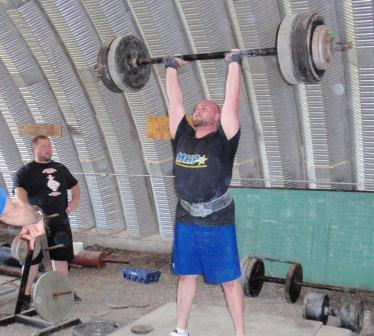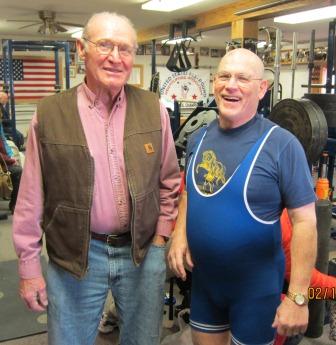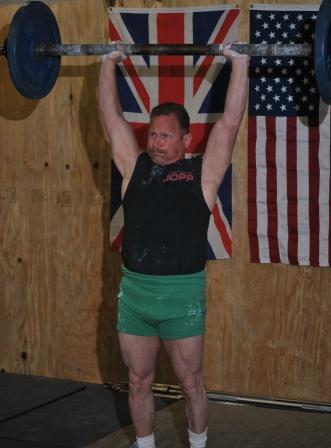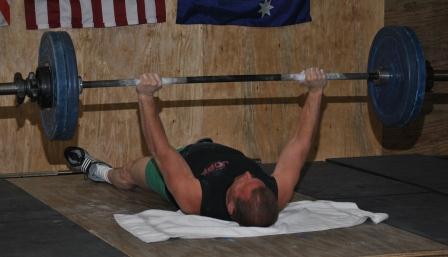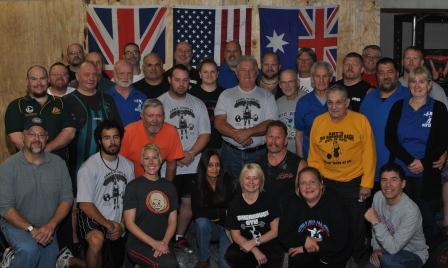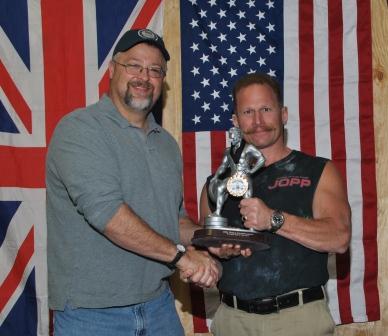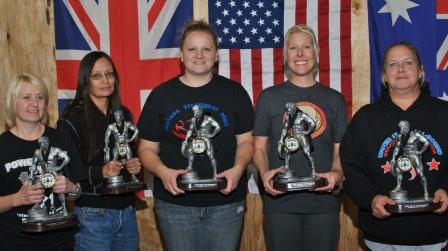By Dan Wagman, PhD., CSCS
Consultant, Body Intellect
Publisher/Editor in Chief, Journal of Pure PowerBody Intellect Sports Performance Enhancement Consortium
As part of my training for worlds, I have visited the USAWA website off and on. A topic that caught my attention is the consideration by the IAWA to allow lifters to use knee sleeves. I thought that a rational and scientific analysis of this question might aid in the decision-making. Thus, I will look at what this sport stands for, what research shows on the topic of knee sleeves from a health and performance enhancement perspective, and what the sum of that information indicates in terms of allowing knee sleeves in all-round weightlifting.
ADVOCATING RAW STRENGTH
As step one let’s clarify what the sport of all-round weightlifting stands for. The mission of all-round weightlifting is to test pure, raw, unadulterated maximal strength in a large number of different exercises. A review of IAWA rules supports this. Only in the squat and front squat is the type of equipment that artificially enhances the strength of an athlete—in the form of knee wraps—allowed. This, despite the fact that many other lifts also test the muscles that provide strength and stability to the knee.
In the case of the squat and front squat the main mission of all-round weightlifting seems to be compromised. But consider that in all other lifts the use of performance-enhancing devices isn’t permitted and one must still come to the conclusion that in this sport the use of implements that artificially inflate an athlete’s strength is contrary to the sport’s purpose, mission, and conviction. Indeed, even the use of minor aids such as taping of the thumbs and/or fingers (as permitted in weightlifting) or the use of baby powder for the deadlift (permitted in powerlifting) is not allowed in all-round weightlifting. Though the use of wrist wraps and a belt is authorized, they don’t fall into the same category as knee wraps; the former’s primary function is to only provide joint stability as opposed to outright performance enhancement by aiding in the movement of the joint through its range of motion as knee wraps do. Admittedly, there does appear to be a lack of consistency within the rules of the sport regarding the use of equipment. However, it is equally apparent that because in the overwhelming majority of lifts no outright performance enhancing equipment such as knee wraps is allowed, the sport’s main mission is to remain pure and uncontaminated in the test of maximal strength.
WHY STRAY?
With the fundamental purity of all-round weightlifting in mind, what argument would support changing the rules to allow for the use of knee sleeves? Could it be overall knee health? From a sports medicine perspective, there is absolutely no reason, nor evidence, as to why a healthy knee would require any degree of support, or warming, or anything else in order to move through its full range of motion, even under the sort of substantial load you would experience from, say, a heavy squat.
Consider that one of the ligaments of the knee (posterior cruciate ligament or PCL), designed to keep the thigh and leg together firmly, has been found to have an ultimate strength of up to around 1,000 pounds and another (anterior cruciate ligament or ACL) up to 540 pounds (10, 12, 15), and that the forces of a squat would actually be distributed among a total of four ligaments (though to varying degrees), not to mention tendons and muscles and bones, then it seems clear that the knee joint doesn’t need any artificial help. Of course you might argue that the stresses of lifting weights adds to the stresses of the knee. But first you ought to consider that there is a training effect. In other words, as you train to get stronger so does the rest of your body, including all structures of the knee from exercises that stress that joint. Then consider that research has shown that the max forces of a 615-pound squat only amount to about 450 pounds of shearing forces upon the most highly stressed ligament of the knee during that exercise (PCL) (9), and you’ll have to again conclude that the knee doesn’t require any additional help.
ON HEALTH
But what about an unhealthy knee, say a knee with arthritis? Might that knee benefit from a knee sleeve? And does that benefit constitute the type of performance enhancement that would violate the spirit of all-round weightlifting? Allow me to share my findings with you from a search of all relevant sports medicine research on knee sleeves.
In a review study that looked at a total of 444 people with arthritic knees, knee sleeves improved pain over just taking medication (non-steroidal anti-inflammatory drugs).(2) In another study that looked at overuse injuries to the knee (not arthritis) in 395 army recruits, those that wore a simple elastic knee sleeve had significantly better comfort levels than those who didn’t.(5) Another study wanted to find out about the time-period of improvement.(11) Here, in the beginning weeks of the study patients with osteoarthritis who took meds and wore a knee sleeve did better than those who only took meds. But toward the end of the two-month study there was no difference between using a knee sleeve or just taking meds. Another study also found that wearing an elastic knee sleeve provided immediate pain relief for subjects with osteoarthritis who participated in a stair-climbing power test.(3)
So what about the heat-retaining aspect of a knee sleeve? Many athletes believe this to be perhaps the most important aspect of a knee sleeve. A study conducted at the Indiana University School of Medicine found that the differences were so minor between the knee sleeve and the no knee sleeve conditions, that the investigators couldn’t draw any meaningful conclusions.(8) Of course you have to take exercise into consideration, too. So a study seeking to find out what differences might exist in treating an arthritic knee with exercise, a knee brace, exercise and knee brace, or exercise and knee sleeve found no statistical differences between any of the treatments.(7) In other words, if you exercise, you get just as much pain relief as you would from adding a knee brace or a knee sleeve.
PERFORMANCE ENHANCEMENT
A critical concern for any sports organization has to deal with what sort of ergogenic aids it will or won’t allow. As it pertains to knee sleeves, one must obviously consider the type of knee sleeve because they aren’t all created equal. I have a knee sleeve that I received as a promotional gift from Titan Support Systems. It is difficult to argue that this knee sleeve is the same as what you would get from a pharmacy or physical therapist; it’s very thick, tight, and rather non-elastic providing much spring to a squat. Unfortunately, there is no research available that sought to quantify the differences in ergogenic properties from this sort of knee sleeve to the one manufactured for people suffering from arthritis. Despite the lack of empirical evidence, it seems rather clear that there is little difference between the Titan knee sleeve and knee wraps, especially if you also consider that a tighter knee sleeve, one that might require two people to don, just like tighter knee wraps will enhance performance more than loser ones. And of course, the more stability a knee sleeve provides the joint, it naturally follows that it will also provide resistance to bending the joint, which in turn means more assistance during lockout.
But performance enhancement doesn’t need to be limited to the obvious, such as aiding the knee in locking out. It can also entail more subtle things such as how a knee sleeve might be able to benefit your balance, kinesthetic feedback, brain signaling, etc. Naturally, the person who doesn’t get this sort of benefit is at a sporting disadvantage. Please consider that all of the findings that follow employed a medical knee sleeve, not the kind you find in powerlifting circles. Now, obviously balance is a big part in most if not all lifts contested in all-round weightlifting, but perhaps most in one-armed lifts. With that in mind, consider that patients wearing a knee sleeve were able to balance better in static and dynamic conditions compared to those who didn’t wear such a sleeve.(4)
Part of being able to balance effectively means that you actually have a sense of where your body is in space. A lot of this sort of kinesthetic feedback comes from the joints. So might wearing a knee sleeve improve a person’s sense of knee joint position during a leg extension and leg press? Yes, but perhaps the most interesting finding of a study that looked precisely at that was that the degree of benefit derived from wearing a knee sleeve was highly person-dependent.(1) In other words, some people got a lot from it, others much less. Another similar study found that wearing a knee sleeve consistently improved proprioceptive acuity, meaning that your sense of position and movements are enhanced.(6) Of course as an athlete you have to deal with the effects of fatigue. Obviously, as you fatigue your performance will suffer. A study published in the Scandinavian Journal of Medicine and Science in Sports found that by wearing a knee sleeve while fatigued, joint position senses were significantly enhanced.(14)
From a scientific perspective, it seems rather clear that wearing a knee sleeve can be beneficial in terms of enhancing performance. But what could be causing this? Scientists from the Department of Rehabilitation Sciences and Physiotherapy at Ghent University Hospital in Belgium looked at brain activity while wearing a knee sleeve.(13) They used a method called functional magnetic resonance imaging, which allows you to watch changes in the brain as they occur. What they found is that wearing a knee sleeve while moving influences brain activity in a positive way.
FAIR COMPETITION?
A logical and rational approach to answering the question regarding knee sleeves in all-round weightlifting must first address whether doing so would compromise what the organizations that govern this sport stand for. In this case, it seems clear that the overwhelming evidence stands for testing maximal strength sans any type of equipment that might enhance performance. Of the over 100 lifts that can be contested, only the squat and front squat allow for performance-enhancing knee wraps. Though perhaps misguided, to the rational person this only constitutes an aberration to the overall mission of the sport, not necessarily a precedent for allowing additional equipment.
And yet one must ask that if it’s indeed permissible to use knee wraps in two lifts, by what logic would it not be permissible to use the exact same equipment in all similar lifts? And by this extension of rational thought, why would knee sleeves not be permissible? Of course if they do become permissible, one must also ascertain under what rules of logic would it then not be permissible to use elbow sleeves? After all, an argument based on anatomy and physiology would fall way short in allowing for a sleeve around the large and powerful knee joint, yet not for the elbow joint.
Clearly the research on knee sleeves in an arthritic population shows that it can hold many benefits from pain reduction to increased proprioception and being able to deal with the effects of fatigue. A legitimate need to wear a knee sleeve would be having an arthritic knee. But from an organizational perspective, how does one determine the degree of arthritis and the extent to which it limits the athlete and causes pain? Does that athlete have to bring a doctor’s note to competition? How else would one determine wether a competitor suffers from this sort of medical condition, or a related one, or just wants to have an unfair advantage over his/her competition? And why should an allowance be made in the first place for an injured athlete? Isn’t sport supposed to test the most capable of bodies? It’s one thing to allow a person to use drugs to control pain, an entirely different situation for allowing the use of mechanical devices a person wears to control pain (and thus enhance performance).
In the final analysis it seems that the first test is what the sport of all-round weightlifting stands for. With that in mind, the only rational answer to the knee sleeve question is not to permit it for any lift. The second tier of reasoning ought to look at any anatomical, physiological, or biological need for the use of knee sleeves. As we have learned, the knee and its associated structures are immensely strong, rendering the need of knee sleeves gratuitous, even in the arthritic knee as exercise controls pain well. And in all-round weightlifting, we sure exercise.
References
1. Birmingham, T.B., et al. Effect of a neoprene sleeve on knee joint position sense during sitting open kinetic chain and supine closed kinetic chain tests. American Journal of Sports Medicine. 26(4):562-566, 1998.
2. Brouwer, R., et al. Braces and orthoses for treating osteoarthritis of the knee. Cochrane Database Systematic Reviews. 25;(1):CD004020, 2005.
3. Bryk, F., et al. Immediate effect of the elastic knee sleeve use on individuals with osteoarthritis. Revista Brasileira De Reumatologia. 51(5):440-446, 2011.
4. Chuang, SH., et al. Effect of knee sleeve on static and dynamic balance in patients with knee osteoarthritis. Journal of Medicine and Science. 23(8):405-411, 2007.
5. Finestone, A., et al. Treatment of overuse patellofemoral pain. Prospective randomized controlled clinical trial in a military setting. Clinical Orthopaedics And Related Research. 293:208-10, 1993.
6. Herrington, L., et al. The effect of a neoprene sleeve on knee joint position sense. Research in Sports Medicine. 13(1):37-46, 2005.
7. Lun, V., et al. Effectiveness of patellar bracing for treatment of patellofemoral pain syndrome. Clinical Journal of Sports Medicine. 15(4):235-240, 2005.
8. Mazzuca, S.A., et al. Pilot study of the effects of a heat-retaining knee sleeve on joint pain, stiffness, and function in patients with knee osteoarthritis. Arthritis and Rheumatism. 51(5):716-721, 2004.
9. Nissel, R., et al. Joint load during the parallel squat in powerlifting and force analysis of in vivo bilateral quadriceps tendon rupture. Scandinavian Journal of Sports Science. 8:63-70, 1986.
10. Noyes, F., et al. Biomechanical analysis of human ligament grafts used in knee-ligament reparis and reconstructions. Journal of Bone and Joint Surgery. 66A:344-352, 1984.
11. Pajareya, K., et al. Effectiveness of an elastic knee sleeve for patients with knee osteoarthritis: a randomized single-blinded controlled trial. Journal of the Medical Association of Thailand. 86(6):535-42, 2003.
12. Race, A., et al. The mechanical properties of the two bundles of the human posterior cruciate ligament. Journal of Biomechanics. 27:13-24, 1994.
13. Thijs Y., et al. Does bracing influence brain activity during knee movement: An fMRI study. Knee Surgery, Sports Traumatology, Arthroscopy. 18(8):1145-1149, 2010.
14. Van Tiggelen, D., et al. The use of a neoprene knee sleeve to compensate the deficit in knee joint position sense caused by muscle fatigue. Scandinavian Journal of Medicine and Science in Sports. 18(1):62-66, 2008.
15. Woo, S., et al. Tensile properties of the human femur-anterior cruciata ligament-tibia complex. The effects of specimen age and orientation. American Journal of Sports Medicine. 19:217-225, 1991.

